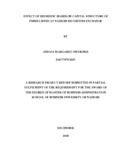| dc.description.abstract | The study sought to find out the effect of heuristic biases on capital structure of firms
listed at Nairobi securities exchange. Anchoring bias, representative bias and availability
bias constituted the three main variables under heuristics. Descriptive research design
was employed. A census survey was used to collect data from a population of 44 listed
firms at Nairobi securities exchange as at 31st December, 2017. Data from firms was
collected using semi structured questionnaires. In order to test for assumptions of
multiple linear regressions, Normality test was done using a histogram; linearity test
employed a scatter plot, while multicollinearity was tested using Variance inflation factor
(VIF). SPSS tool was adopted to analyze data using descriptive statistics, correlation
analysis, regression analysis and ANOVA. Correlation results revealed that there was a
weak positive correlation between capital structure and heuristic biases which was not
significant, (r = 0.024, p= 0.872), firm size had a weak negative correlation with capital
structure which was insignificant (r = 0.036, p = 0.798). Profitability had a weak positive
correlation with capital structure which was statistically insignificant (r = 0.016, p =
0.911) while tangibility had a strong positive correlation with capital structure that was
statistically significant(r = 0.749, p < .001), finally growth opportunities had a weak
negative correlation with capital structure which was statistically insignificant(r = -0.021,
p = 0.892). However statistically significant correlations was between capital structure
and tangibility (r = 0.749, p <0.05). Regression analysis revealed the following: 59.8% of
capital structure could be explained using heuristic biases, firm size, profitability, and
tangibility and growth opportunities. The regression coefficient showed that heuristic
biases influenced capital structure negatively by -2.814, Firm size had a negative effect
on capital structure by -0.413, profitability influenced capital structure positively by
0.029, and tangibility had a positive effect on capital by 3.962 while growth opportunities
positively influenced capital structure by 0.077. However statistically significant
variables in regression coefficients were heuristic biases, firm size and tangibility at p
values 0.043, 0.022 and p< 0.001 respectively. The model summary was significant at p
<0.05 while the F test revealed (F (5, 40) = 14.397, p< .001), it was significant at p <
0.001 which meant the model was statistically significant in explaining changes in capital
structure. The study concluded that heuristic biases had a negative effect on leverage
levels of firms listed at Nairobi securities exchange. It was therefore recommended that
managers be educated on heuristic biases that might affect their decisions so that they
make informed decisions. The research further recommended that firm managers be able
to draw a balance between appropriate combination of debt and equity to finance
activities of the firms based on valid fundamental principles as opposed to heuristics. | en_US |



